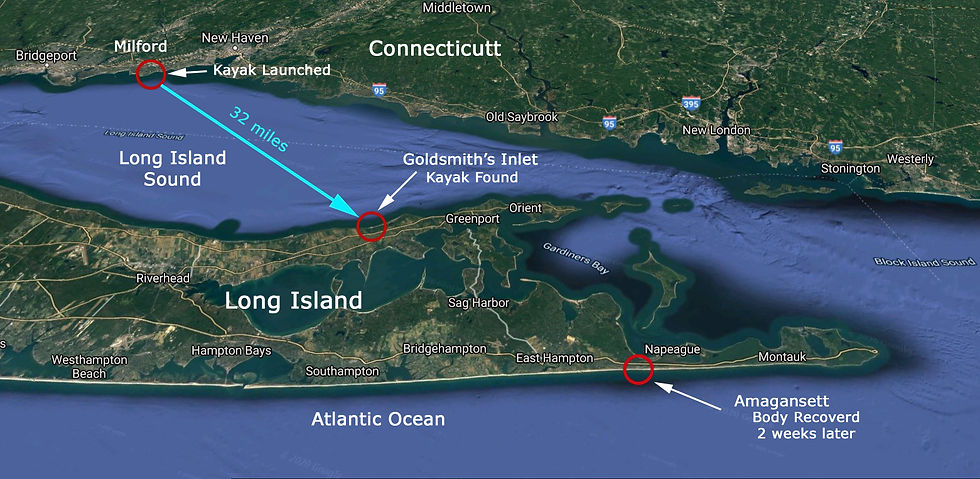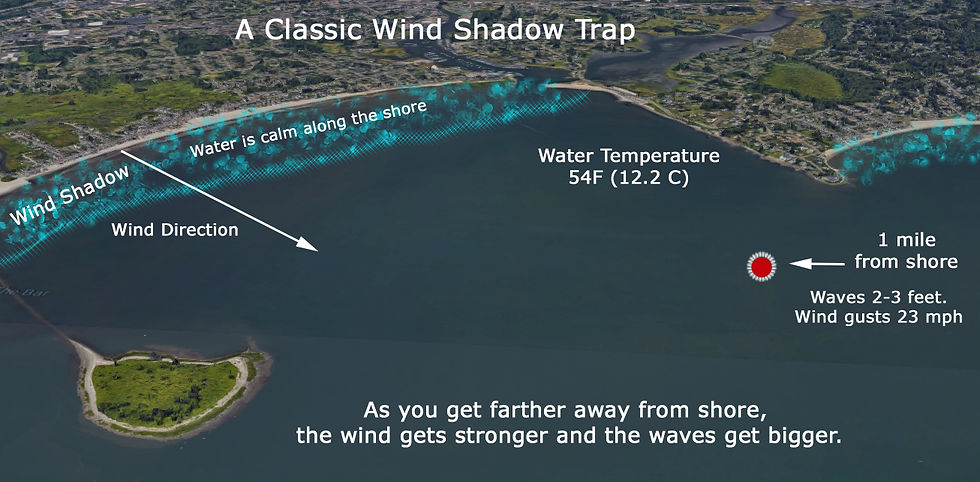Rule 2 / Case 4
- Moulton Avery

- Nov 27, 2021
- 3 min read
Updated: Mar 8
Always Dress For The Water Temperature Fengquan Guan May 9th, 2010 - Milford, Connecticut
While on an annual visit with friends in Milford, Fengquan Guan, 32, of Beijing, went paddling alone on Long Island Sound in a grey, 16-foot double kayak that he had used on previous occasions. He set out at 11 a.m., wearing a black sweater, black jeans, and a Body Glove PFD, for what he thought would be a short trip along the shoreline. The water temperature was a very cold 54F, and conditions in Long Island Sound were rough, with winds gusting around 23 mph and 2-3 foot seas.

When he didn’t return within two hours, Guan’s friend called the local police and the Coast Guard was brought in to search the area. Using helicopters, Falcon jets, and rescue boats, police and Coast Guard personnel initially canvassed 1,250 square miles searching for him. The search was finally called off the next day at 9 p.m. after no sign of either Guan or his kayak could be found.
One day later, however, the search was resumed, again without success, when his kayak was discovered by Southold police officers, swamped at the high tide line in Goldsmith's Inlet - which is 32 miles away on the opposite side of Long Island Sound from where he launched his kayak. His body was finally recovered two weeks later when it washed ashore on Ocean Beach in Amagansett. The Body Glove PFD was found washed ashore nearby, suggesting that perhaps it wasn’t properly fastened and came off in the water. [Click photos to zoom]


The Wind Shadow Trap
This is another classic example of a paddler falling into a wind shadow trap, and to understand how Guan got into trouble, we need to look at the location and weather conditions where he launched his kayak. Milford lies in a crescent shaped indentation of the Connecticut coast that’s quite protected unless wind is blowing from the East or South. On that day it was blowing from the West.
Offshore conditions in Long Island Sound were quite rough, but because of the wind shadow, and also because offshore waves in the distance appear much smaller than they actually are, the water would have appeared fairly calm to Guan when he was standing on shore preparing to launch his kayak. That's why wind shadow traps are so dangerous.

Guan had planned to take a short paddle along the shoreline, but at some point he got far enough offshore that his kayak was caught by the wind. This can happen very suddenly and without warning when the boat leaves the protection of the wind shadow.
He was unable to paddle back against the wind, something that's particularly challenging for a single paddler in a double kayak. As he was blown farther away from shore, conditions became much rougher and he eventually capsized.
His kayak was blown 32 miles across Long Island Sound and washed up in Southold on the north shore of Long Island. The current carried his body out around Montauk Point and into the Atlantic Ocean, and then south along the coast until it washed up on a beach in Amagansett.
Major Contributing Factors
Not Dressed For Water Temperature
Unable To Recover From Capsize
Unable to Call For Help
Unaware of Hazards
Lack of Weather Awareness
Unable To Deal With Wind and Waves
Paddling Solo




This is also a very good post which I enjoy reading. It is not every day that I can see something like this. Call Girls in Amritsar | Amritsar Call Girls | Call Girls Amritsar | Amritsar Escorts | Amritsar Escort | Escort Service Amritsar | Escort Service in Amritsar | Amritsar Escort Service | Amritsar Escorts Services | Call Girls Service in Amritsar | Call Girls Service Amritsar | Escort Amritsar | Escort in Amritsar
tigro game register
Begin your journey with tigro game register by completing the easy registration process. During the tigro game register step, you’ll provide your mobile number or email, set a secure password, and agree to terms to create your account. After tigro game register, you’ll gain access to the full platform of games and features. Ensure that you complete any required verification and keep your login credentials safe. Once you finish tigro game register, you’re ready to explore what the platform offers.
Looking for dependable support when medical needs arise for seniors at home? Consider Elderly Medical Care at Home — the right choice for tailored health-care services right in the comfort of one’s residence. From vital sign monitoring to wound care and medication management, Elderly Medical Care at Home ensures seniors receive professional attention without the stress of hospital transfers. Choosing Elderly Medical Care at Home offers peace of mind, continuity of care and a familiar environment that supports recovery and wellbeing. Let your loved ones stay safe, comfortable and cared for.
Safety and preparation are everything, especially in unpredictable conditions. Just like in Sprunky, where mastering the flow and timing of music requires attention and strategy, paddling safely demands knowledge, skill, and respect for the environment.
This tragic story is a sobering reminder of the importance of preparation and awareness when venturing into nature. It’s similar to how FNF online teaches players to anticipate challenges in rhythm gameplay — understanding the environment is key to success, whether on the water or in a game.